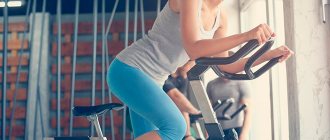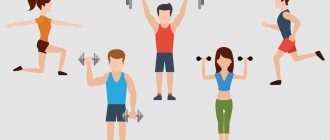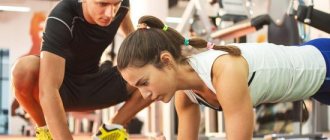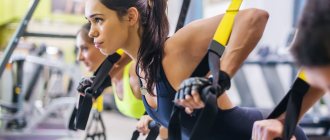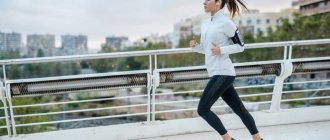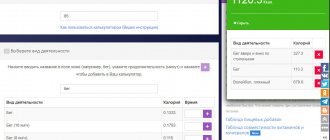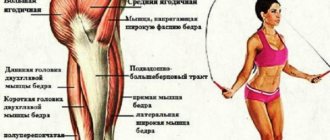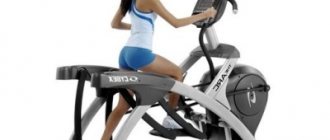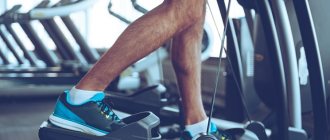If you want to lose weight, you need to monitor not only the number of calories entering your body, but also their expenditure. The more active your life is, the more energy you spend. This helps not only to expend more energy, but also to speed up your metabolism for improved metabolism.
Strength training is a great way to burn calories. You don't even have to visit a fitness center with a gym to burn off those extra calories. The exercises can also be done at home. Today we will tell you how abdominal exercises help in the fight against excess weight.
Online calculator for calculating calorie consumption
Whether you're trying to shed extra pounds or just want to know how many calories you're burning during a workout, an online calculator can help. The amount of energy consumption depends not only on physical activity, time, but also on weight. Enter the indicators in the appropriate columns and get an approximate result.
You will burn:
Fat equivalent:
It is also necessary to take into account the intensity of execution. If you only lift your torso off the floor a couple of times per minute, you are unlikely to burn the required amount of calories during the workout. On average, you need to do 30-50 times per minute. Only in this case will you get the desired effect.
What should be the calorie deficit to lose weight without harm to the body?
To lose excess weight, you need to create a calorie deficit, that is, a situation where calorie expenditure is higher than calorie intake. To do this, you don’t have to limit your diet; you can increase your physical activity. Many people, when trying to lose a lot at once, create too large a calorie deficit, which leads to muscle loss, exhaustion and poor health.
To lose weight easily and safely, you need a calorie deficit of approximately 15-35 percent of the total calories burned per day. Then the weight will go away gradually, without loss of muscle mass and deterioration in well-being. If you burn 2000 kcal per day, then by consuming 20% less, 1600 kcal, you will lose weight quickly and without unpleasant consequences for the body.
If you suddenly experience severe back pain during exercise, consult a doctor, since pain in such cases is unacceptable.
Oh, yes, I also do intestinal cleansing (bran/fiber + enema) - this week every day, next week it will be every other day, and so on, there are articles and guides on cleansing, a therapist friend doesn’t mind (I tried it myself, she liked).
Why is it important to pump up your abs during training?
Exercise done at a fast pace really helps burn calories. But the main purpose of abdominal training is to pump up the abdominal muscles. This complex is especially useful for those losing weight.
It's no secret that when losing weight, muscle tissue is lost first. As a result, the muscles begin to sag and folds of skin appear. Abdominal pumping helps maintain a flat stomach and create sculpted abs.
So, according to experts, pumping the press helps:
- strengthen the rectus muscles;
- burn calories;
- improve posture;
- strengthen the spine.
Include abdominal exercises in your regular workouts and you will notice how your figure improves - fat tissue gradually changes to muscle mass, and your stomach becomes flatter.
Some myths about pumping up abs and burning calories
In pursuit of burning calories, ladies want not only to maintain their slim form, but also to lose several kilograms, gain elastic hips and buttocks, as well as a slender waist. Is it possible to achieve all these goals with just one abdominal pump? Let's talk about some myths, the veracity of which is in question.
- Slim waist . It is not possible to obtain a “wasp” waist with the help of abdominal exercises. Please note that pumping up the abs, accompanied by lifting the torso, is aimed at losing weight and burning fat in all active parts of the body, and not in any specific one. That is, if you can boast of being slim, then of course you can gain a thin waist, which you certainly already have. If the waist is difficult to catch, then the effect of pumping up will not be so bright.
- Without physical activity, muscles will turn into a layer of fat . Firstly, muscles will never become fat by nature, since they have a slightly different physiological structure. Secondly, the lack of regular training only reduces the volume of muscles, but does not change their structure in any way. If you stop exercising, you will gain weight faster, but the muscles will not go away.
- With regular abdominal swings, your body will become as sculpted as that of professional bodybuilders. We believe that such a myth should scare girls rather than attract them. To turn a woman’s body into a “muscle mannequin” you need not only to exhaust yourself with training, but also to adhere to a very strict and complex diet.
- Daily 200 abdominal swings will allow you to create an elastic stomach, like the professionals. For such results, it is necessary to use several types of abdominal exercises, involving execution at different angles, as well as considerable volume.
- With age, hopes for a toned, flat stomach fade. Of course, with age, a person’s muscle mass becomes smaller, but regular training allows you to keep your body in shape, so you shouldn’t be lazy and convince yourself that it’s not possible to achieve a slim body naturally.
- Abdominal crunches are not effective in the fight against calories. By pumping up your abs, you increase your muscle mass, which means you will burn more calories throughout the day. Therefore, feel free to pump up your abs, and also choose other types of exercise for yourself - aerobics, kangaroo jumping, etc.
How many calories are burned by doing abdominal crunches 100 times?
If you perform the exercise at an average speed, then you will be able to pump your abs 100 times in 3 minutes. The table shows calorie consumption for different weights:
| Weight, kg | 55 | 60 | 65 | 70 | 75 | 80 | 85 | 90 |
| calories | 20 | 22 | 23 | 24 | 27 | 29 | 31 | 33 |
As you understand, the higher the weight, the faster calories are consumed. But if you have extra pounds, don’t try to set records in the speed of lifting your body. This way you increase the load on your neck and back, which does not help pump up the abdominal muscles, but only creates discomfort in the spine.
Calories in
So, in order to lose excess weight, it is necessary to ensure a negative balance between calories in and calories out. Therefore, the first step is to understand how many calories are in the “arrival”.
All food that enters our body consists of basic nutrients - Proteins, Fats and Carbohydrates, abbreviated as BJU. Each nutrient has its own energy value, namely, how much energy a given nutrient can provide to our body if used as fuel. Energy is measured in joules (J); in nutrition, it is usually measured in calories (cal). The correspondence between the second and the first looks like 1 cal = 4.184 J. [1] If the body uses proteins or carbohydrates as fuel, then this gives 4 kilocalories (kcal) per 1 gram of substance used, if fats - then 9 kcal.
For example, if we ate 2 eggs and a sandwich with butter and cheese for breakfast, then the energy value of our meal will be [2]:
- Eggs B = 12.7 g % F = 11.5 g % Y = 0.7 g % kcal = 157 (100 g serving)
- Russian cheese B = 23 g % F = 29 g % U = 0 g % kcal = 72 (serving 20 g)
- Wheat bread B = 8.7 g % F = 1.5 g % Y = 39 g % kcal = 21 (10 g serving)
- Butter 82.5% B = 0.5 g % F = 82.5 g % Y = 0.8 g % kCal = 75 (10 g portion)
- In total, the total calorie content of breakfast will be 325 kcal
According to the example given, the entire daily calorie content is calculated and this is the amount of energy that we have in the so-called “arrival”. To lose weight, you need to spend more energy (kcal) than you consume or eat less than you expend. No less important is alcohol. One gram of alcohol is 7 kcal. For example, 100 ml of vodka contains 40% alcohol, which gives 40 * 7 = 280 kcal. 100 ml of beer contains from 4 to 7% alcohol, sugar 3 - 4%, therefore, if you drink a “bottle” (0.5 l) of beer, you can get about 230 kcal (based on U = 3.5 g%, alcohol 4.5 g% 3.5 *4*5 + 4.5*7*5)
How many calories are burned by doing abdominal crunches 50 times?
If you want to limit the exercise to just 50 lifts, don't expect to burn a lot of calories. One approach will take you from 10 to 15 calories, which is an insignificant energy expenditure for weight loss.
But don't stop doing the exercise. If you exercise regularly, you will be able to speed up your metabolism, which will make the weight loss process go faster. Try to perform 50 abdominal exercises 2 times a day to speed up weight loss.
How many calories do you need to burn to lose weight?
If you're serious about losing weight, you need to know how many calories you need to consume and how many to burn. To more accurately calculate how many calories you need to consume, the Miffin-Geor formula is used to calculate basal metabolic rate (BMR).
Do you want to lose weight? Then these articles are for you
Exercises for the pectoral muscles for girls at home
Fitness for weight loss at home video course 30 days
Weight loss workouts in the gym for men
Basal metabolic rate for women:
GV = 10 * weight (kg) + 6.25 * height (cm) - 5 * age (years) - 161
Basal metabolic rate for men:
GV = 10 * weight (kg) + 6.25 * height (cm) - 5 * age (years) + 5
The resulting basal metabolic rate should be multiplied by a factor depending on your activity level:
How to pump up the press correctly
For a positive effect, it is important not only the number of approaches, but also the correct execution of the workout. If you strain your neck and back muscles too much, you will not get the desired result.
Lie on your back with your feet slightly wider than hip-width apart and your knees slightly bent. For beginners, you can hold your hands behind your head, but you don’t need to pull your neck trying to lift your body. The most correct position is with your arms along your body, your palms a few centimeters from the floor. Or cross your arms in front of your chest, clasping your shoulders.
Tighten your abdominal muscles, exhale, pull your navel towards your spine and lift your entire body up with a straight back, simultaneously lifting your head, neck and shoulders off the floor. It is not necessary to take a sitting position; it is quite enough to linger at the point when you raise your shoulders from the floor by 10-15 centimeters.
Pause for a moment, inhale and lower yourself back to the floor. The spine should touch the floor first, then the shoulders, neck and crown of the head. Make sure your tailbone and lower back are flat on the floor. To do this, you will need to pull your hips forward and twist slightly upward.
Basic rules for abdominal training:
- do exercises before meals;
- alternate with cardio exercises;
- watch your breathing - lift your body as you exhale, lower your body as you inhale;
- be sure to warm up your muscles with a light warm-up before starting classes;
- gradually increase the repetitions, bringing the exercise up to 150-200 times in one approach;
- Train every other day to give your muscles time to recover.
By doing your abs correctly, you will also strengthen the deep muscles surrounding your spine, which will help prevent back injuries.
Tip: If you experience discomfort in your tailbone and lower back when lifting your body, place a flat small pillow under your hips or perform the exercise on a yoga mat.
How energy expenditure is measured
Methods for determining energy expenditure are called calorimetry. There are two such methods - Direct and Indirect calorimetry.
- Direct, the method is labor-intensive and is rarely used, only in laboratory conditions. It is almost impossible to apply it to a person, especially during various types of physical activity. The very meaning of the method is that, assuming that all types of energy in the body are ultimately converted into heat, then by determining the amount of heat released by the body, you can calculate the number of calories expended. With this measurement, the subject is placed in an isolated volume, such as a pressure chamber, in which the change in temperature of the subject can be recorded. Doing this, say, with laboratory mice is quite possible, but with a person who performs some type of physical activity, you understand, it is quite problematic. Therefore, in relation to people, the second method is used.
- Indirect calorimetry is based on the measurement of the main oxidation products of organic substances, which include carbon dioxide (CO2) and nitrogen (NH3). For this, a portable breathing device is used - a gas analyzer, which measures the amount of inhaled O2 and exhaled CO2. This method is not as cumbersome as the first one, and it can be used for various types of activities, say, the load on an exercise bike and measuring an athlete’s energy expenditure in this case is quite simple.
To measure energy consumption using this method, tables and the so-called are used. Respiratory Coefficient (RK).
Respiratory Coefficient is the ratio of CO2 released by the body to oxygen consumed O2. This coefficient for carbohydrates is equal to 1, for fats – 0.707, for proteins 0.801. [1]
Having measured the amount of inhaled O2 and exhaled CO2, the first step in calculating energy expenditure is to take into account the energy expenditure of protein. To do this, the nitrogen excreted in the urine is analyzed. With normal sweating, the amount of urine nitrogen will correspond to the amount of oxidized proteins - 1 g of urine nitrogen = 6.25 g of protein. [1] Thus, the total amount of nitrogen will make it possible to calculate the total amount of protein consumed.
The second step of the calculation is to determine “protein-free” energy expenditure. To do this, the corresponding values of gases used for protein metabolism are subtracted from the total volumes of CO2 and O2. It has been established that the oxidation of 1 g of protein consumes 966.3 ml of O2 and produces 773.9 ml of CO2 [1]. By multiplying these values by the amount of oxidized protein and subtracting these values from the total volume of measured gases, the remainder is protein-free values of carbon dioxide and oxygen.
Next, the Respiratory Coefficient is included in the calculation. The CO2/O2 ratio will show in what proportion the energy consumption of carbohydrates and fats occurred. The resulting amount of fats and carbohydrates is multiplied by the caloric value of the corresponding substance (9 kcal for fats and 4 for carbohydrates) and the already calculated caloric content of oxidized proteins is added at the rate of 1 g x 4 kcal. As a result, the total energy consumption is obtained using the Indirect Calorimetry Method.
How to intensify your ab workout
A set of exercises for the abdominal muscles will help you achieve better results. To further increase the load, you can conduct classes on a fitball, lowering your upper body onto it and leaving your feet on the floor.
Bike
This is a great way to train the lower and transverse abdominal muscles, which are not used during regular ab crunches.
To make a bike:
- Lie on your back, bend your legs and stand hip-width apart.
- Keep your hands behind your head, elbows out to the sides.
- Tighten your abs and lift your legs 90 degrees.
- Raise your upper body and hold in this position.
- As you exhale, turn your body, pull your right elbow and left knee towards you.
- Straighten your right leg and hold for a few seconds.
- Inhale and return to the starting position.
- Repeat on the other side.
Perform 30-50 repetitions for best results. To avoid strain, keep your lower back flat on the floor and your shoulders away from your ears. Do crunches using your abdominal muscles without straining your neck.
Leg lowering
Beginners can combine abdominal crunches with this exercise for relaxation. Instead of raising your body, you need to lower your legs one by one, which will help pump up the lower abdominal muscles.
To do the exercise:
- Lie on your back.
- Raise your legs, keeping your knees at a 90-degree angle to the floor.
- Exhale and touch the toes of your right foot to the floor, keeping your left knee in the starting position.
- Go back and repeat on the other leg.
It is important to avoid arching your spine when lowering your leg. To do this, push your buttocks forward and tense your abdominal muscles.
Side crunches
Don't forget about the obliques. This exercise will help pump up the side muscles that are not used during regular training.
To do the exercise:
- Lie on the floor with your spine firmly pressed to the floor.
- Place your hands behind your neck and lift your legs, bending your knees at a 90-degree angle.
- As you exhale, lower both knees to the right and hold at the bottom for 10 seconds.
- Return to the starting position and repeat on the other side.
Don't lift your shoulders off the floor. Twisting should occur only with the lower back due to the tension of the oblique abdominal muscles. When performed correctly, twisting also helps relieve pain from a pinched nerve in the spine.
These simple exercises will help you tone your abdominal muscles. And in combination with cardio training, abdominal pumping is a good way to get rid of excess calories.
Come on, burn: the most effective exercise machines are calorie killers
Moscow 24 columnist, fitness expert and TV presenter Eduard Kanevsky told what types of cardio equipment are more effective for losing excess weight and how to understand which exercise machine is right for you.
Photo: depositphortos/didesign
Autumn is the start of a new season of the reality show “I want to lose weight,” which is why there is an unprecedented rush in fitness clubs, especially in the morning and evening hours. In addition, it is also cold outside, so those who decided to take care of themselves were also joined by fans of street training who did not really want to get wet in the rain.
And the main question that beginners ask: “Which weight loss machine is the most effective?” Probably, in the minds of most of these clients there is an image that, after working out for two weeks, they will lose a dozen extra pounds gained over the years, the main thing is to choose the right exercise machine! They are partly right, because there really are less effective and more effective simulators. But it is important to understand that not only your results, but also the safety of your training will depend on the correct choice of equipment.
Looking ahead, I will say that, no matter how effectively you exercise, seventy percent of the achievement of your goals and objectives will be played by a proper diet with an emphasis on protein foods and vegetables. It is also necessary to minimize foods containing sugar, do not forget to exclude flour, fatty foods, processed foods, fast food, chips and alcohol, especially beer.
So which exercise machine can be considered the most effective in terms of calorie consumption? Let's go in order.
Photo: depositphotos/minervastock
Running is considered the most natural type of aerobic exercise for our body. After all, it is during running that the muscles of the legs, body, and arms work as hard as possible. Also, the process involves a strong consumption of calories, unlike, for example, cycling. And it’s not for nothing that in any fitness club the lion’s share of exercise equipment is made up of so-called treadmills. But it’s one thing when you run by yourself, pushing off the ground, and another thing when your leg is pulled back by a motor, and your only movement is moving your leg forward. In other words, if you compare the simulator with natural running, then the effectiveness of the simulator is less. This is one of its disadvantages, but it does not mean that the simulator is not effective.
But the main contraindication to exercising on a treadmill is problems with the musculoskeletal system. Most often these are injuries to the spine, as well as knee, ankle and hip joints. If you are absolutely healthy, then a treadmill is the ideal equipment for the most effective training. The average calorie burn for a 45-minute session is between 400 and 500 units.
The second most popular exercise machine in any cardio zone is the so-called elliptical trainer, which many mistakenly call “skis”. In fact, the movement you perform with your legs has nothing to do with movement on the ski track or the “skating” style. In an elliptical trainer, the leg moves in a given range of motion - it is an oval or ellipse. The main advantage of the simulator is that your legs are fixed on the footrest, which means there is no so-called shock load on the joints and spine, plus you have the opportunity to grab the movable handles, involving a large muscle mass. An elliptical trainer is as expensive as a treadmill in terms of the number of calories burned. Moreover, it is absolutely safe for a number of injuries or pathologies.
Photo: depositphotos/CandyBoxImages
Let's move on to exercise bikes. This is equipment that is available in any cardio zone. Clubs with large areas often add a rarer type of equipment to standard upright exercise bikes – recumbent exercise bikes. And it’s not for nothing that they do this, because for people with serious obesity, problems with the spine, as well as varicose veins, a horizontal exercise bike is preferable. After all, it has a comfortable large back, unlike vertical exercise machines, which means the load on the spine is minimal. Thanks to horizontally positioned legs, the load on the veins of the legs is significantly reduced, which is recommended for varicose veins.
The choice of equipment does not end with this “standard” set of cardio equipment for any fitness club. Nowadays, such a direction of functional training as CrossFit is very popular. And one of the mandatory types of exercise equipment that is used in this direction is the rowing machine. In essence, this machine imitates “academic” rowing on sports kayaks. There you have two movements: you “row”, pulling a special handle to your stomach, and then sharply straighten your arms, plus you actively work with your legs, as the seat under you moves along the sled. It turns out that you straighten your legs and at the same time pull the handle, and then sharply come back, straightening your arms and bending your legs. The faster you try to perform a movement, the harder it becomes.
The result is an intense workout that simultaneously engages almost all muscles, which means significantly increasing calorie consumption - up to 600 per workout. True, precisely because of the intensity of the lesson, rarely does anyone stay on this simulator for more than ten to fifteen minutes. In addition, such intense exposure is allowed for people without any problems with the musculoskeletal system. It is also undesirable for various forms of pathologies of the cardiovascular system.
Kanevsky Eduard
